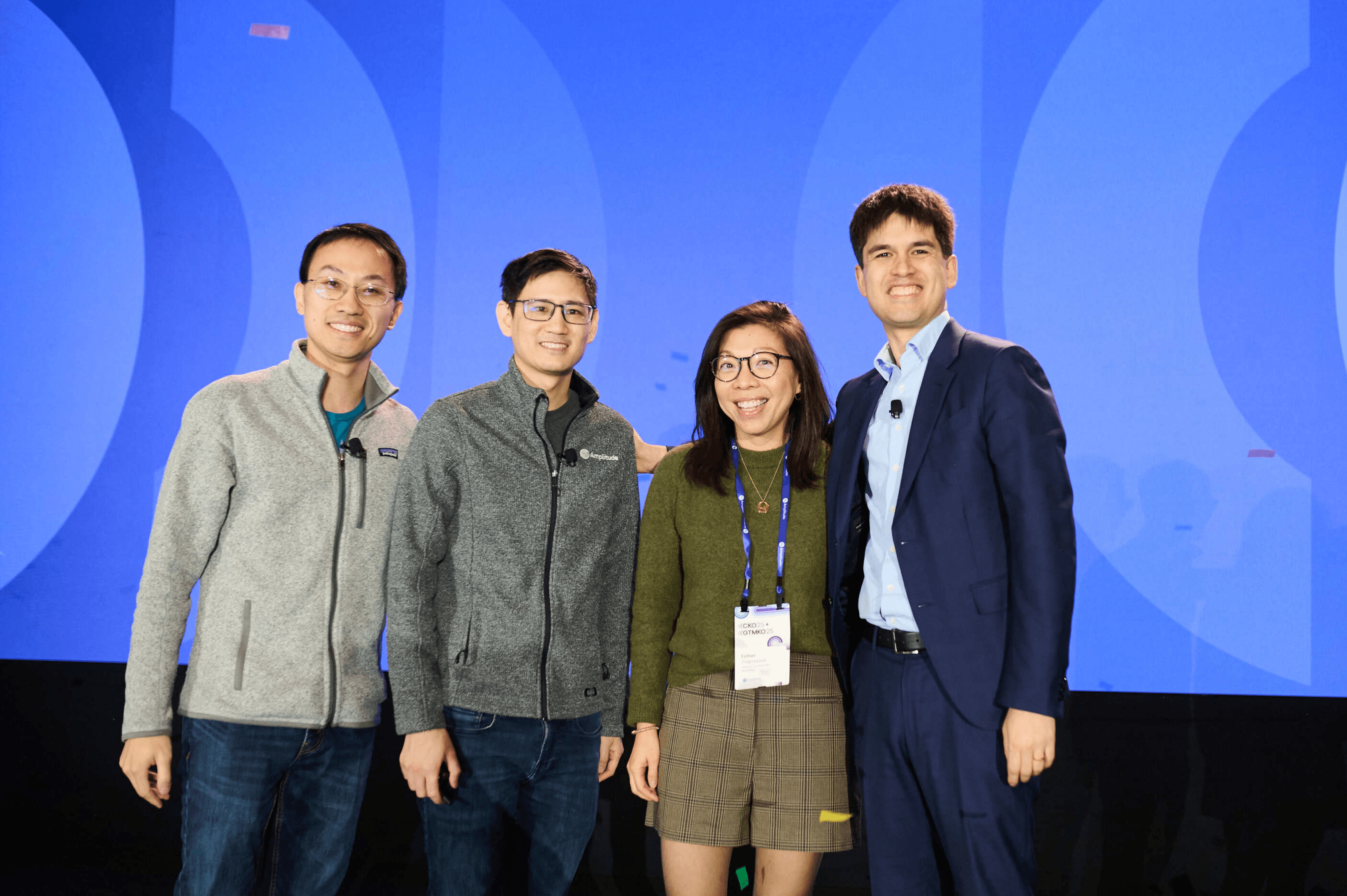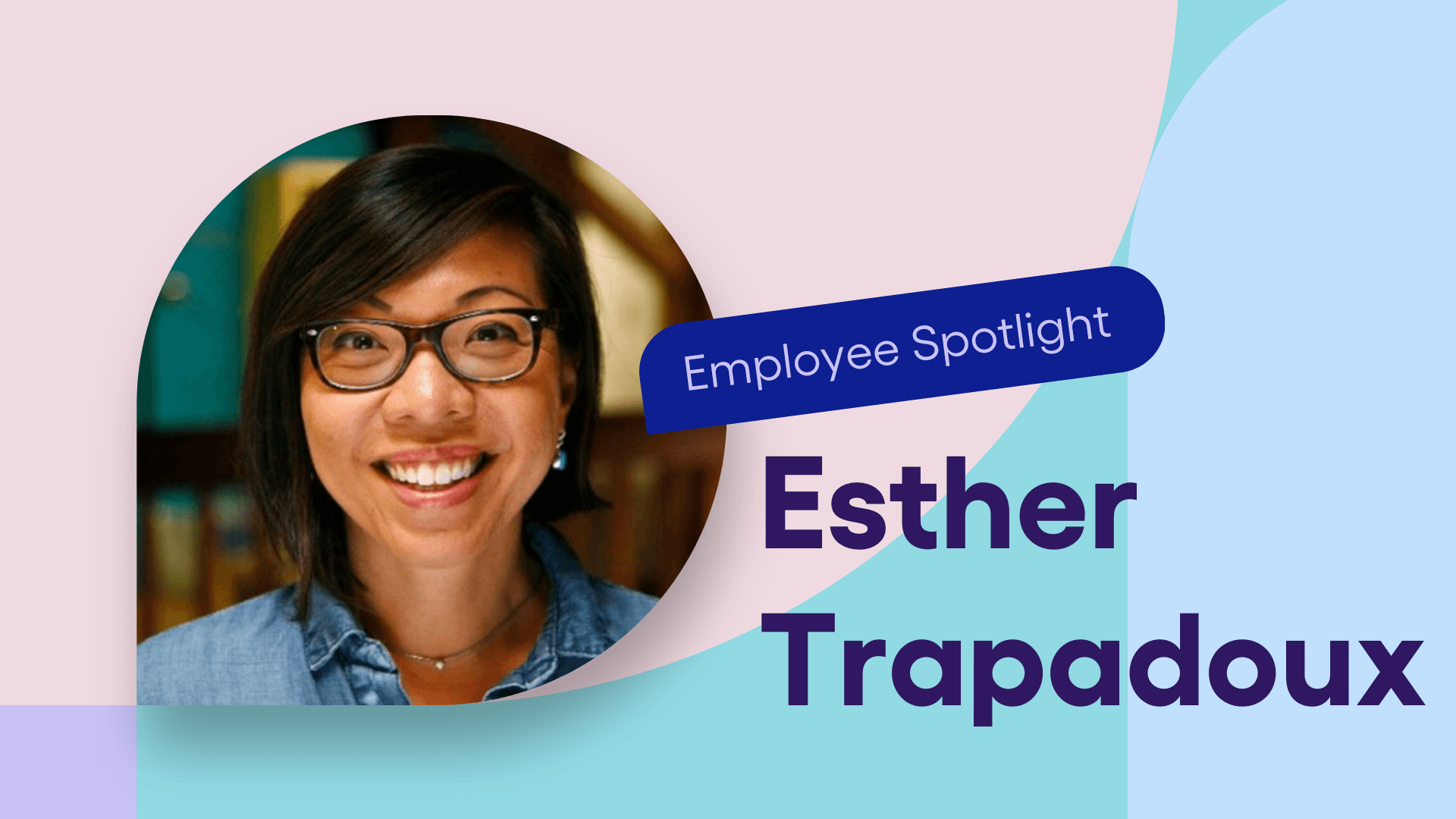Amplitude Founders’ Award Winner: Esther Trapadoux
Celebrating 2024 Amplitude Founders’ Award recipient and Advocacy, Customer Marketing, and Community Director Esther Trapadoux!
At Amplitude, we believe great businesses are built by empowering great people. The Founders’ Awards represent our company's highest recognition, celebrating the Ampliteers who embody what it means to think and act like a founder.
As the late, great Steve Jobs once quipped, “It doesn’t make sense to hire smart people and then tell them what to do. We hire smart people so they can tell US what to do.” That ethos is at the heart of Amplitude’s beginnings, and since day one, we’ve strived to foster an environment where our people don’t simply excel in their jobs—they take a step back, see the big picture, and boldly tell us what needs to happen to drive the business forward. In other words, they think—and act—like a founder.
Today, we recognize one such Ampliteer who has risen to the challenge and is shaping Amplitude’s future with the same relentless vision and drive that built it.
Esther Trapadoux, Director, Community
Esther was nominated for Amplitude’s Founders’ Award for turning the Amplitude Community into a powerhouse for engagement, retention, and growth. Since January 2024, she’s grown the Community by 34% to more than 20,000 members, making it a go-to space for customer feedback, product discussions, and beta testing. Thanks to her leadership, more than 80% of enterprise accounts and 20% of free-plan users actively participate, creating a thriving network of advocates and product champions. She also played a key role in connecting the Community with Amplitude’s product development team, ensuring customer insights shaped the roadmap and led to better experiences and higher satisfaction.
Beyond just growing the Community, Esther launched game-changing programs to help users get more value from Amplitude. Her How I Amplitude series features real customers sharing their workflows, reaching over 1,200 people and sparking fresh ideas. She also introduced Wizard Bars—live office hours where customers could connect with Amplitude partners and solutions experts. These events were so impactful that attendees kept spreading the word, bringing even more people into the Amplitude ecosystem. Thanks to Esther’s vision and execution, the Community isn’t just a support forum—it’s a major driver of Amplitude’s success.
Congratulations, Esther!
Tell us about yourself and what brought you to Amplitude
I’ve been a digital marketer for my entire career, and solely in B2B. When I joined Amplitude three years ago, I was the company’s first growth marketer in Europe and eventually a founding member of our Global Growth Marketing team.
I sort of fell into Community by accident, and it’s certainly not a path I ever expected to go down. But over two years ago, the growth marketing team was given a remit to overhaul Amplitude’s community strategy and take total ownership over it. I was tasked with leading this initiative, which I’ve been doing pretty much nonstop since February 2023.
What brought me to Amplitude? It’s a product that I’d actually never used but always wanted to touch. I was an early Mixpanel user, and then Piwik (before the Matomo rebrand), and a longtime GA user. But Amplitude was always in the ecosystem as a strong player, thinking about the analytics problem in deep and different ways. I was incredibly nervous and probably had adrenaline pumping through me nonstop as I went through the interview process. It was absolutely a dream job moment when I got hired.
What does acting like a founder mean to you?
I like to own problems end-to-end. I love systems and understanding dependencies. I’m the type of person who likes to be given a problem, the surrounding context, and no goal. From there, I’ll start to map the system in which the problem lives and identify gaps. My main objective is to define the goal and connect the dots in new and interesting ways to uncover opportunities we didn’t recognize before; find hidden treasure and growth. And when work exists like this, it becomes really fun. We rely less on known tactics or copying programs from competitors. Because we’ve connected the dots in different ways and found a new path to get us to our goal, we can experiment and stretch our creativity. Everything is fast and moves quickly because we’ve redesigned the problem space vs. something overly digested and laden with assumptions.
I don’t know if this is what it means to act like a founder. But I guess founders like to own problem spaces vs. tactics, so that’s what looking like a founder means to me.

What makes a brand’s community valuable to its members and the business?
A community is centered around its members. Not the brand. Not the product. And not our messaging. A community done well is a force multiplier for a company.
At its heart, a community is maybe a company’s best shot at removing the strange walls businesses put between themselves and their members (in this case, our customers). We go to our members instead of pulling them to us.
The goal is to build a horizontal network.
What makes this valuable? I’d argue that horizontal networks with many endpoints and pathways are more flexible and stable than vertical networks. There are a whole host of reasons why horizontal networks are stronger in this context: a stronger sense of ownership across the base, and leveraging an army of experts across our full ecosystem of power users, partners, influencers, and our users. Horizontal networks have repetitive pathways across the world, industries, and job functions. This makes us far less dependent on centralized nodes that rely on a few players that can potentially leave at any moment. Vertical networks are less stable; there are centralized points of failure that can wipe out entire branches and strategies in just one move.
Finally, horizontal networks evolve quickly. Smaller sub-branches and subsystems are free to grow at a pace and direction defined by their members. Different needs and priorities can thrive across the community without hindering other parts. This gives way to an incredible amount of creativity and innovation that builds a speed a vertical network can’t keep up with.
What have you learned about fostering meaningful engagement in a community, and what advice would you give those looking to build something similar?
There’s lots of great content to get people started and incredible communities to join and experience yourself.
There’s no one-size-fits-all solution for community building, as tempting as it is to copy and paste programs from other communities.
I’d probably start with this:
- Lean into your differentiator. You’re creating a product that’s competing with everything else, trying to grab people’s attention. You’re not just competing with other communities. Focus on the value you’re creating for a specific audience and understand how you can create value as quickly as possible. People will leave a community as quickly as they join one.
- Talk to your members and prospective members. Learn their needs and what their day-to-day and challenges look like. And imagine where your community would fit into their lives. Does it solve a work problem? Does it help them fill a personal need? The more inputs you gather from your members, the faster you’ll be at connecting the dots and building programs to serve them.
- Give, give, give, and then take. Channel your internal Muhammed Ali and his classic jab-jab-hook strategy. In this case, we’ve added an extra “jab” to emphasize how much you need to give before you can ask for things from your members. One of the best pieces of advice I received from a community builder is to model the behavior you want to see in your members. Do you want to create vulnerability and safety? We did, because we knew asking analytics questions and the topic of data, in general, requires a safe space. So we put ourselves out there with our “stupid questions” and things we shared. Don’t ask members to be the first ones to put themselves out there and put the entire burden of breaking the ice up to them.
- Your members are your key stakeholders. In our case, these are Amplitude users. The business will pull you in many directions, and it’s easy to get sucked into this. But your goal—especially if you’re building a vendor community—is to protect and advocate for your users' interests. Your critical mission is to find the intersection of where you can create value for users and the business. You should exist in this problem space and continually solve for it through your strategy and programs.
Interested in shaping the future of digital products alongside leaders like Esther? Visit our careers site to see how you can make an impact at Amplitude.

Brittney Lee
Senior Talent Operations Coordinator, Amplitude
Brittney is the Senior Talent Operations Coordinator and Early Careers Program Lead at Amplitude. She supports the operational aspects of the talent acquisition team and spearheads university recruiting efforts. Outside of work, Brittney enjoys traveling and exploring new food spots throughout the Bay Area.
More from BrittneyRecommended Reading

The Product Benchmarks Every Healthcare Company Should Know
Dec 29, 2025
5 min read

The Product Benchmarks Every Media and Entertainment Company Should Know
Dec 23, 2025
5 min read

Amplitude Pathfinder: Why Austin Costello is a Triple Threat Analyst
Dec 22, 2025
8 min read

Introducing Amplitude on Amplitude
Dec 22, 2025
3 min read

